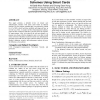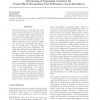10602 search results - page 17 / 2121 » Weakly Useful Sequences |
ECCV
2008
Springer
14 years 11 months ago
2008
Springer
Abstract. The use of sparse invariant features to recognise classes of actions or objects has become common in the literature. However, features are often "engineered" to...
ICUIMC
2009
ACM
14 years 3 months ago
2009
ACM
This paper presents a detailed review of remote user authentication schemes with smart cards based on bilinear pairings. The first scheme regarding this was proposed by Manik et a...
JSAC
2010
13 years 3 months ago
2010
Jamming-resistant communication is crucial for safety-critical applications such as emergency alert broadcasts or the dissemination of navigation signals in adversarial settings. I...
CATS
2008
13 years 10 months ago
2008
Weak equivalences are important behavioral equivalences in the course of specifying and analyzing the reactive systems using process algebraic languages. In this paper, we propose...
ICML
2005
IEEE
14 years 10 months ago
2005
IEEE
This work provides a framework for learning sequential attention in real-world visual object recognition, using an architecture of three processing stages. The first stage rejects...


